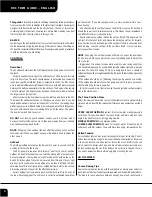
Owner’s Manual Page 162
Pre-Launch and Underway - Section S
Remember that all boats steer by the stern (the feeling
is much like steering your automobile in reverse). This
means that the stern of your boat will swing in the
direction opposite to your turn. For example, when you
turn the helm wheel to the left, the stern of your boat
will swing in the direction opposite to your turn. This is
especially important to keep in mind when docking,
operating in close quarters with other boats, or when
approaching a swimmer or downed skier in the water.
Always look behind you and to both sides of the boat
before slowing down. Tell your passengers your
intentions to allow them time to make adjustments to
their balance or positions.
Slowly pull back on throttles, glance back and see if a
large following wave is approaching the transom. If so
give the engines a little throttle as the wave arrives to
keep wave from rolling over the transom.
Once you have spent enough time practicing maneu-
vers and have a feel for how the boat handles, you will
be ready to run in open waters.
S - 6 ACCELERATION
Before accelerating to bring you boat on plane,
be sure that the area in front of your boat is
clear. The bow will rise out of the water
momentarily before you plane and may
temporarily obstruct your vision.
If you have never had your boat on plane before,
choose a calm day for your first on plane experience.
Never boat beyond your ability and experience.
Before bringing your boat “on plane”, check the entire
area to make sure you have a clear, safe path. As you
throttle up to accelerate, your boat will increase its
angle of trim, causing the bow to ride high. From a
maximum angle, the boat will level out to its planing
attitude with continued acceleration. This maximum
angle is known as the “hump”. Because visibility,
handling, and performance are reduced, it is advisable
to get “over the hump” as soon as possible. A few
seconds at full throttle should get the boat over the
hump and into its planing attitude.
After getting over the hump, accelerate until reaching a
comfortable plane, then throttle down to cruising speed.
This also will provide for better fuel efficiency.
S - 7 TRIMMING YOUR BOAT
Trim tabs are used to add lift to the boat’s stern,
thereby changing the boat’s attitude. This lift can help
the boat get on plane faster and remain on plane at
slower speeds than if no tabs were used. Used
independently, tabs can also correct listing conditions
caused by crosswinds, unbalanced loading and
quartering seas.
Before accelerating and trying to gain plane, press
upper button. This will cause both trim tab blades to
lower in parallel and force the bow down when
running. This can also be used when running the
boat with a heavy load aboard.
Moving the trim tab blades downward will in crease
the lift and the boat will achieve plane faster, or stay
on plane at a lower engine and boat speed.
After gaining plane and establishing cruising speed,
pressing the lower button retracts the blades in
parallel and will allow the bow to rise. This should be
used to adjust the run ning attitude of the boat to
decrease the drag at cruising speed or above, or
when run ning in a following sea.
When running at an engine speed that results in the
boat falling off plane or causes the boat to plane
inefficiently, lowering the blades slightly (bow down)
will improve the running angle and improve operating
efficiency.
Optimum efficien cy is obtained when operat ing at a
3 to 5 degree running angle. Utilizing too much “Bow
Down” trim tab can reduce operat ing effi ciency and
cause substan tial stee ring and handling difficul ties.
Be extreme ly careful when running in a following sea.
The effect of trim tabs is ampli fied under such
condi tions. Steer ing and handling difficulties can
result from im proper trim tab usage, espe cially in a
following sea. If unsure of proper trim tab positioning,
raise the trim tabs to the full-up position.
Summary of Contents for V458
Page 1: ...V 4 5 8 O W N E R S M A N U A L 0 9 0 2 8 8 6 ...
Page 2: ......
Page 4: ...Table of Contents Owner s Manual Page 1 Table of Contents ...
Page 5: ...Owner s Manual Page 2 Table of Contents ...
Page 6: ...Table of Contents Owner s Manual Page 3 ...
Page 7: ...Owner s Manual Page 4 Table of Contents ...
Page 8: ...Table of Contents Owner s Manual Page 5 ...
Page 9: ...Owner s Manual Page 6 Table of Contents ...
Page 10: ...Table of Contents Owner s Manual Page 7 ...
Page 11: ...Owner s Manual Page 8 Table of Contents ...
Page 52: ...Owner s Manual Page 50 Warranty and Service Section D ...
Page 54: ...Owner s Manual Page 52 Warranty and Service Section D ...
Page 94: ...Owner s Manual Page 92 Fuel Systems Section I Figure I9 Fuel Valve System Components ...
Page 171: ...Owner s Manual Page 169 Pre Launch and Underway Section S Figure S3 Mooring Lines ...
Page 188: ......
Page 189: ...www fourwinns com ...
















































